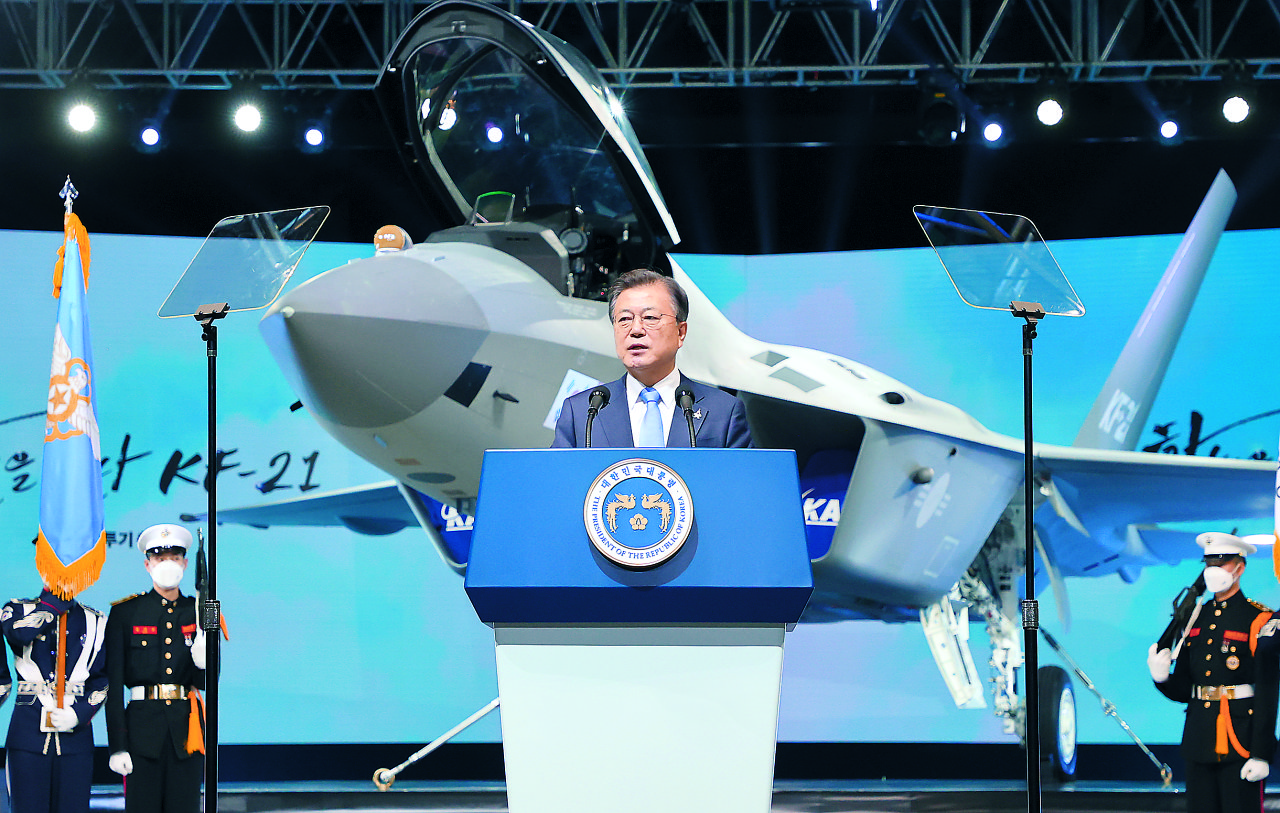The fruit of South Korea’s 20-year quest to make a more independent military with locally built fighter jets took shape Friday, as it unveiled the prototype of its first homegrown jet, the KF-21 Boramae.
President Moon Jae-in hailed the event as marking a new era of self-reliance in the military, describing the jet as the new backbone of the Air Force.
The vision of deploying homegrown warplanes by 2015, announced by late President Kim Dae-jung in 2001, was initially met with doubt. Korea was, and still is, reliant on US-made jets, and at the time had little technological know-how to develop an advanced fighter.
A preliminary economic assessment of the KF-X project -- a cost-benefit analysis by government think tanks -- also warned on three separate occasions that the proposal was not worth pursuing.
A new momentum
But the project gained traction in 2009, when an independent university research center reversed the earlier findings, saying the project would be financially sound as Korea had more to gain from a local fighter jet.
A homegrown jet would enable the country to replace retiring US-made jets at a cheaper cost than when it brings in new US warplanes. Local jet exports would also help carve out Korea’s foothold in the global defense market, the center said.
“That was what the Air Force had essentially been saying all along: It was time to grow independent of the US and we stand to gain much pursuing that path,” said a retired Air Force general who was one of key officers on the KF-X project.
“That outside opinion tipped the scale in favor of the project,” he added.
Indonesia, which is Southeast Asia’s largest defense market, joined the KF-X project in 2010, a year after the review came out, agreeing to shoulder 20 percent of the entire costs in exchange for technology transfer. The joint work is worth at least 8 trillion won ($7.1 billion).
“We needed someone from outside to bring down costs and sell the jet to the outside world,” a Seoul official said, declining to be identified as the two countries are still negotiating the terms of the deal.
Another setback
But the project hit another snag in 2015, when the US went back on its promise to share key software for Korea’s 4.5-generation warplanes, a cheaper and less stealthy alternative to US-made F-35, which is the most advanced fifth-generation jet.
Korea decided to localize the key technologies and press ahead with the project. A year ago, it unveiled a key radar technology, called active electronically scanned array, or AESA.
“We were not turning back. And our numbers showed we weren’t wrong. Finding another country or scrapping the project altogether was not good math,” said a former senior official who was working on the project at the time in 2015.
The president told the team to “make the project succeed,” according to the official, who added that the public support from the commander-in-chief did not calm skeptics, but helped the team to deliver on their commitment to building an independent fighter jet amid discord over the project.
He said that Korea was fortunate to have been able to “connect the dots” in such a short time because it had been working on similar technologies in the past.
“Radars go everywhere, from surface-to-air missiles to warships. We’ve been working on those for so long. We were building on that know-how,” said Shin Hyun-ik, senior researcher who led the team to localize the technologies.
Still, one dispute remains to be solved. Indonesia has been sitting on its contribution to the project. Economic difficulties are reportedly among the reasons. The Korean government said Indonesia’s pullout would not affect the project.
“We thank the Indonesian government for believing in us and being our partner,” Moon said at the rollout ceremony. The KF-21 starts mass production after five years of flight tests, with Korea planning to produce 120 jets and Indonesia, 48.
By Choi Si-young (
siyoungchoi@heraldcorp.com)








![[Today’s K-pop] Blackpink’s Jennie, Lisa invited to Coachella as solo acts](http://res.heraldm.com/phpwas/restmb_idxmake.php?idx=644&simg=/content/image/2024/11/21/20241121050099_0.jpg)